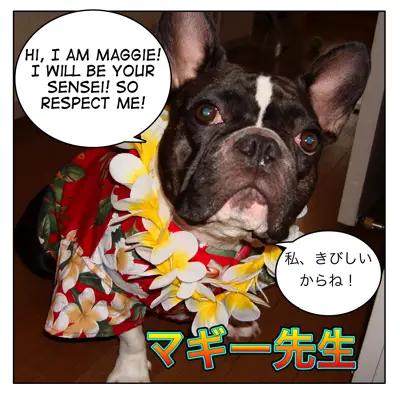「私、きびしいからね!」
= Watashi kibishii kara ne!
= I am strict so be ready, OK?
:n:
Hi I am Maggie-sensei! I will be your teacher. So respect me!
マギー先生です!これからみんなの日本語の先生になります。
= Maggie-sensei desu. Korekara minna no nihongo no sensei ni narimasu.
:r:
今日は!マギー先生です! 今日から正式にこの日本語学習のブログを始めます。
= Konnichiwa! Maggie-sensei desu! Kyou kara seishiki ni kono nihongo gakushuu no burogu wo hajimemasu.
= Hello! I am Maggie-Sensei. I will officially start this Japanese learning blog today.
既にいくつかのサンプルレッスンをアップしています。
= Sudeni ikutsuka no sanpuru ressun wo appu shite imasu.
= I have already posted several sample lessons.
皆さんのレベルがわからないからレッスンによっては簡単過ぎたり難し過ぎるかもしれません。
= Minasan no reberu ga wakaranai kara ressun ni yotte wa kantan sugitari muzukashi sugiru kamo shiremasen.
= Since I don’t know your level, some of the lessons could be too easy or difficult.
がんばってレッスンを作っていくので感想を聞かせてね!
= Ganbatte yoi ressun wo tsukutte iku node kannsou wo kikasetene.
= Please give me feed back so that I can make more useful lessons for you.


5 Comments
Hi Maggie-sensei,
Can I ask how is it different if I were to rephrase
既にいくつかのサンプルレッスンをアップしています。
to
既にいくつかのサンプルレッスンをアップしました。
I think this is similar in nature to the question I asked in
http://142.93.68.150/2009/08/01/mini-listening-shopping-part-1/#comments
about difference between 言いました/ 言った and 言っていました/ 言っていた.
@changkh
Hello changkh!
OK the difference between
1) 既にいくつかのサンプルレッスンをアップしています。
And
2) 既にいくつかのサンプルレッスンをアップしました。
1) 既にいくつかのサンプルレッスンをアップしています。 I have been posted various lessons already
2) 既にいくつかのサンプルレッスンをアップしました。 I already posted various lessons already.
Sometimes we translated the same but the difference is しました implies your action has completed. しています means “has been doing the action” and the speaker will keep posting a new lesson.
I couldn’t help myself since nobody seems to have made a comment on your blog yet so I feel honored to deflower your virgin blog with this disturbing yet slightly amusing message.
I anxiously await for more of your lessons as they are already helpful! Admittedly, I am having trouble with the insane amount of Kanji, and perhaps some furi injections even for the basic stuff would be great?
Kudos on the site, and I’ll see you later!
– Hedgie
Hey maggie-sensei,
I kinda got confused while checking the “previous” lessons: sometimes you put an underlined Kanji, and that kind of makes it hard to distinguish visually. Anyhooo, I like the fact that you’ve given some thought to us 中級!
Hi, ffbittencourt-san! Thank you for your comment! I didn’t think the underlined Kanji might confuse you. I will take it in consideration. Please visit again soon!
コメント有り難う!わかりました。これからはアンダーラインには気をつけますね。また来てね!
Komento arigatou! Wakarimashita! korekawra underline wa kiwotsukemasu! Mata kitene!
Hey, Hedgie-san!! Japanese people also have difficulties remembering all the kanjis. Good luck!
漢字は日本人にとってもたくさんあって大変です。がんばってね! Kanji wa nihonjin ni tottemo takusan atte taihen desu. Ganbattene!